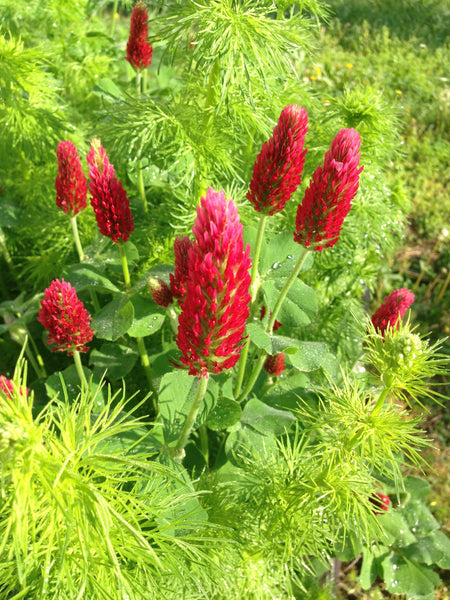You’ve definitely heard the phrase and maybe even taken it for a spin but do you really understand the depth of the role that cover crops play in our gardening lives? Using cover crops to their fullest potential can change everything about how your garden grows from soil fertility to topsoil retention, resulting in better crops and a better environment.

Benefits of Cover Cropping
The benefits of cover cropping tend to vary from crop to crop. Different plants play different roles in the way we care for our gardens. In general though, cover crops are meant to add nutrients and organic matter to the soil, prevent erosion, protect microorganisms, retain moisture, and reduce weed pressure. We’ll get into how they manage to get all this done a little later. Cover crops are cheaper and easier to use than hauling in manure and compost every year or purchasing soil amendments - in fact, it’s kind of like growing your own soil amendments! Do you need more reasons? Their flowers and foliage provide food and habitat for beneficial insects like pollinators, lady bugs, praying mantises. Are you convinced yet? Let’s keep going!
When to Plant Cover Crops
Different cover crops can be planted during different parts of the year. You can plant them and intend for them to grow for a whole growing season in order to nourish and rest a bed or prepare a new bed. You can also plant cover crops briefly in between vegetable or flower plantings to add more organic matter, or grow cover crops throughout the winter time to revive the soil for spring and keep it from eroding. So the answer to your question? Cover crops can grow year round! Something you will want to think about and plan out when you’re seeding cover crops, though, is going to be when you’ll be ready to plant in that area. You’ll want to give your cover crops enough time to germinate and grow (which will depend on the crop) and then enough time to begin to decompose. Typically, this will be four to six weeks.
How to Seed Cover Crops
We offer a bunch of different cover crops and mixes and different seeds for you to explore. In order to sow the cover crops, we recommend broadcasting the seed on top of 1-2 inches of compost or rich soil, raking it in slightly, and mulching lightly with straw. Keeping your cover crop watered is most important between planting time and germination.
How to Process Cover Crops
When we say “processing,” we’re referring to how cover crops go from growing plants to soil amendment and the process that takes. Probably the most important thing to remember about cover crops is to never let them go to seed. They can easily go from beneficial to the annoying weed in your garden. The timing is going to be slightly different depending on the variety. For most plants, this is immediately after it flowers. That holds true for leguminous cover crops like Crimson Clover or Austrian Winter Pea. Buckwheat, on the other hand, can often bear seed at the same time as it flowers which is misleading for the home cover cropper. It’s important to keep a close eye on this crop and process right before it flowers. For other cover crops like those in the grass family, it’s a little harder to tell because it’s difficult to see their flowers with the naked eye. You’ll have to watch for the jointed stem to arise and create a fluffy inflorescence and process at that point.
Now, how do we stop it from going to seed? Cover crop can be managed in several different ways. The easiest is likely to mow or weed whack your cover crop. It can also be pulled out or cut down with shears. Lucky for us, nature also lends a hand with cover crops that “Winter Kill” when planted in Fall. This refers to plants that will die back with a hard frost, doing the work for you!

Which Cover Crops Should I Grow?
How to Use Cover Crops
Step one is going to be to research your varieties and their specific benefits. Using a mixture of different cover crops typically provides the best benefits as a mix can perform more than one task at a time. We can also consider the benefits that diversity contributes to any ecosystem. If you know what your specific soil needs are, you can customize a mixture just for that.
Tap Rooted
Tap rooted cover crops such as alfalfa and radish are especially helpful in clay soils. They work to break up compaction which allows the next crop to root even deeper and access more water and nutrients. Further, they add organic matter to clay soils, bringing more nutrients and creating humus over time.
The nitro radish has biofumigant properties which means that as they decompose they actually release compounds that suppress weeds, soilborne pathogens, and pests. In the case of alfalfa, it is also a legume which makes it nitrogen-fixing on top of its tap rooted benefits. Alfalfa is a great choice for pre-spring planting because it’s so cold hardy.
Want the most beautiful cover crop in town? Try this actual, gorgeous, sunflower! The Oilseed Sunflowers are beloved in cover crop mixes because of the way they attract pollinators and birds. Their deep roots also do wonders for breaking up clay soils and adding air pockets.
Nitrogen Fixing
As cover crops, legumes are largely used to fix atmospheric nitrogen to make it usable for crops. This means fewer applications of fertilizers throughout the growing season! They also reduce erosion, produce biomass, and attract beneficial insects. Legumes tend to decompose faster than grasses so that nutrients are not held up in the plant matter for as long and can be more readily accessible for your crops, though they do not add as much organic matter to soils as other options.
Dutch White Clover is a great choice for growing under plants as a living mulch. It’s low growing so it will not overpower established plants but will keep weeds away. Crimson Clover is a taller clover that is excellent for supporting your local bee population. These beautiful crimson flowers will make you fall in love with cover cropping.
Hairy Vetch, Austrian Winter Pea, and Sunn Hemp all have decent biomass production. Hairy Vetch is great for Spring or Fall planting and grows quickly to suppress weeds. Austrian Winter Pea is a great option for over-wintering and should be sown in fall. Sunn Hemp is a cover crop that is fairly new to North America. It is quick growing and can produce five thousand pounds of biomass per acre. It is a great midsummer cover crop and will die back with frost.
There is a secret to fixing nitrogen with legumes that I want to fill you in on: In order for the nodules on legume roots to effectively fix nitrogen there has to be a certain bacteria present known as rhizobium. This bacteria can be found in soils already but there isn’t a way to be sure that it’s there. By using a Legume Seed Inoculant, you can introduce the bacteria ahead of time and guarantee that your leguminous cover crops will fix nitrogen as effectively as they can!
Bio-mass Builders
Grasses work to establish themselves quickly, creating a generous ground cover and root system that holds your soil in place. They are the shining treasure hunters of the cover crop system, scavenging for nutrients (particularly nitrogen) and pulling them to the soil surface. The tissues of grasses hold onto those nutrients until they decompose where they are now readily available and present for your crops during the next planting. This also means that nitrogen will be held in the soil throughout the winter rather than leaching away during the off season. On the other side of the coin, if your soil is too high in nitrogen (maybe due to an over application of chemical fertilizer), grasses can be planted and then removed rather than turned in, removing that nitrogenous plant tissue from the site and creating a less hostile environment for your crops.
White oats make a great, low cost, quick-growing cover crop. They produce a large amount of biomass in a short period of time. Due to their fast growth they outcompete weeds efficiently. They also have helpful compounds in their roots that hinder weed growth for a few weeks after being killed back. Unlike white oats, winter rye will overwinter beautifully, providing continuous growth and biomass production until mowed back.
Phacelia is a popular plant for floral arrangements and its agricultural prowess. This gorgeous purple flower produces a large amount of biomass while providing a huge amount of nectar and pollen, attracting bees and hoverflies from all over.
Need for Speed
Buckwheat is our favorite quick fix for an empty garden bed. Maturing in just 6-8 weeks, this cover crop can help you out in a pinch! Because it grows so quickly, it’s helpful to hold over planting areas in between crops when weeds could come in. Its roots loosen topsoil and they access and hold phosphorus in their tissues, storing it for the next planting. It also tolerates infertile soils, so it’s great when used in areas that are established but just need a little boost of organic matter.
Cover Crop Mixes
All ecosystems love diversity, including your garden. Using cover crops in partnership with each other offers diversity and the benefits of solving more than one problem at a time. Consider what actions you’d like your cover crops to do and choose plants for those needs. Perhaps you’re looking for the clay busting and biofumigant properties of the Nitro Radish but also want something that will keep your ground covered in the winter. Growing the radish and Winter Rye together when planted in fall can do all of those things for you! We also offer a list of cover crop mixes for every season; Spring, Fall, Winter, and Summer

The Short and Sweet Version
-
Timing
- Decide on your needs and plan accordingly. Cover crops should grow and be processed within the time frame you need.
-
Selection
- Different species serve different purposes. Do your research and make your cover crops work for you!
-
Don’t underseed
- Following seeding guidelines will set you up for success. Planting too little seed will leave gaps and weeds will come up and spoil your plans. If you get poor germination the first time, plant again two weeks later.
-
Don’t let the cover become the weed
- The time to kill back cover crops is before it sets seed which will depend on the varieties you’re growing.
-
Don’t give your cover crops a complex
- Cover crops can do a whole lot but set them up for success! Pair this method with other weed control and nutrient management techniques to round out your organic gardening methods and create a truly diverse practice.

|
Article Written by: Hannah Gibbons |
|
About the Author: Hannah Gibbons, an employee at Sow True Seed since 2020, has nearly a decade of experience in the agricultural industry. Their passion for environmental education and regenerative agriculture has been the cornerstone of their work, aimed at making gardening accessible to all. |



